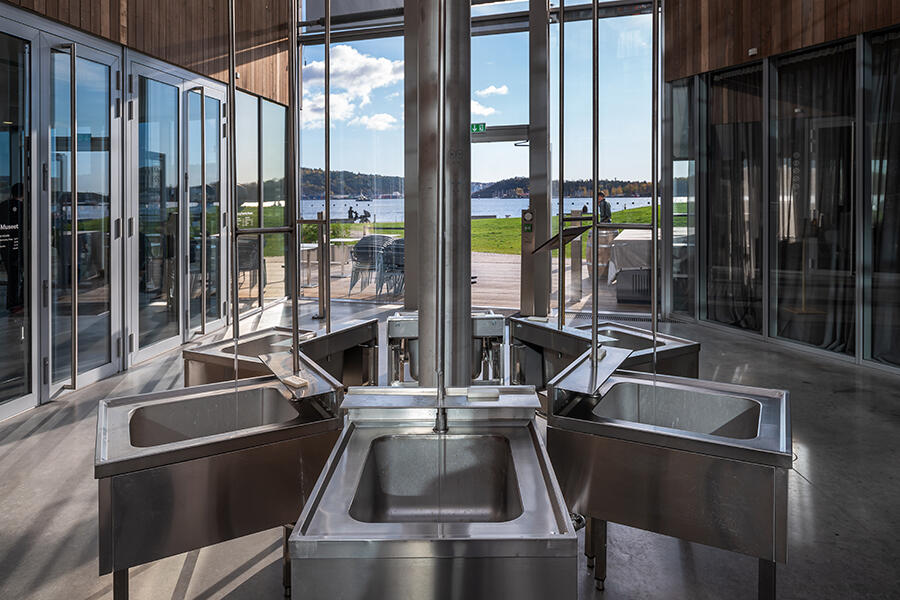Sissel Tolaas and the Politics of Smell
The artist’s retrospective at Astrup Fearnley Museet, Oslo, considers how smells can speak to discourses around capital, class and colonization
The artist’s retrospective at Astrup Fearnley Museet, Oslo, considers how smells can speak to discourses around capital, class and colonization

To investigate smell, write Constance Classen, David Howes and Anthony Synott in Aroma (1994), is to study nothing less than ‘the essence of human culture’. Our olfactory preferences and distastes are contingent on the place we call home while our personal scent betrays the work we do, the foods we digest and our living conditions. In this sense, Sissel Tolaas’s ‘RE________’ at Astrup Fearnley Museet Oslo, which is concerned with exactly this relationship between smell and culture, might be the most ambitious and evocative exhibition I have ever visited. Distributed across seven indoor and outdoor spaces, ‘RE________’ provides an olfactory archaeology of the present by unearthing, restoring, categorizing and numbering scents from nearly all of the continents, a range of social contexts and a wide variety of materials – including human skin, money, metals, fear, sweat, the ocean, seeds and melting ice.

The first two sensory experiences bespeak this range. In the museum’s entrance hall, visitors are asked to wash their hands using soap smelling of the artist’s own skin (Self_Life_Fountain, 2005–ongoing). At the ticket office, each person is handed a glass flacon containing perfume smelling of money (Liquid_Money_1, 2000–ongoing). Outside, there is a sauna in which visitors can steam their bodies in the smell of money before jumping into the sea to rinse off (Liquid_Money_2, 2021) – a whitewashing of sorts. ‘RE________’ spans the intimate and the abstract, the personal and the systemic, labour and exchange; further, it suggests that each of these qualities is always already intrinsic to the others: having washed your hands in Tolaas’s scent and then dabbed them with the smell of cash, you carry both aromas with you as an inseparable part of your own body odour.

Downstairs, the museum’s voluminous central space is offset by a series of installations: grey and pastel-coloured rocks, some natural some artificial, each with its own smell, as if hacked directly from our world’s various aromascapes (EI_AI, 2012–22); holes carved into the walls to indexically resemble usage marks on the floors, exuding the scents of the materials that were cut through – wood, metal, insulation materials (BeYondUnderNeath, 2021); 365 glass sculptures patterned across the floor, each blown by and containing a single one of the artist’s breaths (one for each day of the year) (StillALife, 2020); a wall panelled with the wood stripped from its obverse on the building’s exterior (INsideOutIn, 2021). There is also a magical, multi-storey installation resembling an alchemist’s distillery, where a set of hanging lab glasses bubble and steam with the fragrances of a natural world in crisis: each aroma a plant’s warning-signal to others that danger is near (SYMBIOTIC AGREEMENT, 2019–ongoing).

All of these works are political, invoking discourses around capital, class and colonization the Anthropocene and the nonhuman, memory and environment. But three pieces are explicitly antagonistic, even violent: a neon-rose coloured room stinking nauseatingly of salmon farms (Salmo_NO_Way, 2001); a series of melting ice blocks releasing the aromas of seeds from Svalbard Global Seed Vault (DEEP TIME_, 2010); and, suggestive of the extent to which we are part of the environment we are destroying, a wall covered in paint infused with NanoSmell, which, upon being rubbed, releases the odours of 21 men who are afraid of being touched (FEAR 21/21, 2002).
Art, films and literature show us how to see and ‘read’ the world, but these activities are beholden to rules – perspective, narrative, etc. – that have become so entwined with power that they are often one and the same. It’s for this reason that Tolaas’s exhibition is so original and effective: it forces us to experience our world through an entirely different register, one whose rules sniff out hegemony without being reduced to it.
Sissel Tolaas, ‘RE’________’ is on view at Astrup Fearnley Museet, Oslo, until 30 December 2021.
Main image: Sissel Tolaas, 'RE________’, 2021, exhibition view, Astrup Fearnley Museet, Oslo. Courtesy: the artist and Astrup Fearnley Museet, Oslo; photograph: Christian-Øen






















